Related Research Articles

The Concerto for Orchestra, Sz. 116, BB 123, is a five-movement orchestral work composed by Béla Bartók in 1943. It is one of his best-known, most popular, and most accessible works.

Hugo Emil Alfvén was a Swedish composer, conductor, violinist, and painter.
The Hungarian Dances by Johannes Brahms (WoO 1), are a set of 21 lively dance tunes based mostly on Hungarian themes, completed in 1879. They vary from about a minute to five minutes in length. They are among Brahms's most popular works and were the most profitable for him. Each dance has been arranged for a wide variety of instruments and ensembles. Brahms originally wrote the version for piano four hands and later arranged the first ten dances for solo piano.
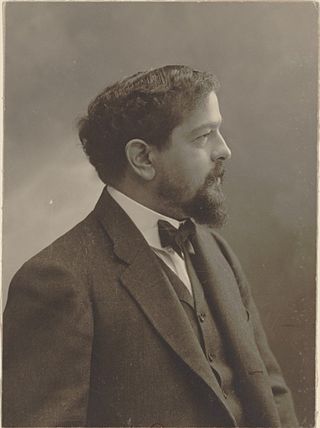
Prélude à l'après-midi d'un faune, known in English as Prelude to the Afternoon of a Faun, is a symphonic poem for orchestra by Claude Debussy, approximately 10 minutes in duration. It was composed in 1894 and first performed in Paris on 22 December 1894, conducted by Gustave Doret. The flute solo was played by Georges Barrère.
Songs Without Words is a series of short lyrical piano works by the Romantic composer Felix Mendelssohn written between 1829 and 1845. His sister, Fanny Mendelssohn, and other composers also wrote pieces in the same genre.
Miguel del Águila is an Uruguayan-born, American composer of contemporary classical music who has been nominated thrice for Grammy.

Three Pieces for Blues Band and Symphony Orchestra is an avant-garde musical composition written by William Russo in 1968. It combines classical music played by an orchestra with blues played by a four-piece band.
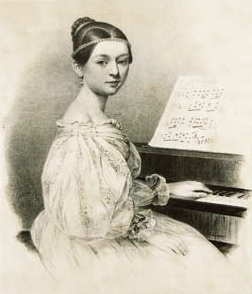
The Piano Concerto in A minor, Op. 7, was composed by Clara Wieck, better known as Clara Schumann after her later marriage to Robert Schumann. She completed her only finished piano concerto in 1835, and played it first that year with the Leipzig Gewandhaus Orchestra, conducted by Felix Mendelssohn.

Ailbhe McDonagh is an Irish concert cellist and composer. She performs worldwide as a soloist, chamber musician and recording artist with many albums to her name. In addition to her playing, McDonagh is a prolific composer having written works for orchestra, chamber music ensembles and pedagocial purposes. Her compositions have been published by Boosey & Hawkes, Hal Leonard, RIAM and ABRSM. McDonagh is a professor of cello at the Royal Irish Academy of Music in Dublin, Ireland.

Hallowe'en, also initially entitled Allegro vivace: Hallowe'en, is a short composition for piano quintet by American composer Charles Ives. It was probably composed in 1907 and was part of Three Outdoor Scenes, a collection of pieces that also included Central Park in the Dark.
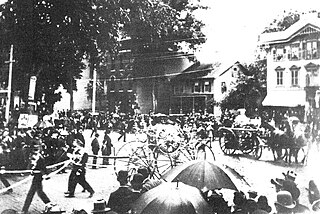
The Gong on the Hook and Ladder or Firemen's Parade on Main Street, normally shortened as The Gong on the Hook and Ladder and also initially entitled Allegro moderato, is a short composition by American composer Charles Ives.

"Hymn: Largo cantabile", S. 84/1, sometimes also referred to as "Largo cantabile: Hymn" and often shortened as "Hymn", is a composition by American composer Charles Ives written in 1904. Grouped in the suite A Set of Three Short Pieces, it is published and commonly performed as a standalone work.
Music for the Dance No. 2 is a composition for piano by American composer Leonard Bernstein. It was finished in 1938.
The Piano Sonata, originally entitled Sonata for the Piano, is the only piano sonata by American composer Leonard Bernstein. An early work by the composer, it was finished in 1938.
Touches: Chorale, Eight Variations and Coda, often shortened as Touches, is a composition by American composer Leonard Bernstein. Composed in 1980, it is one of Bernstein's last compositions for solo piano.
Four Sabras is a short composition for solo piano by American composer Leonard Bernstein. Each Sabra refers to vignettes or portraits of different fictitious Israeli children.
The Anniversaries are a series of short compositions of easy difficulty for solo piano by American composer Leonard Bernstein. These compositions were written over the course of forty years as gifts for people Bernstein was acquainted or friends with on the occasion of their birthday. The published series comprises the following works:
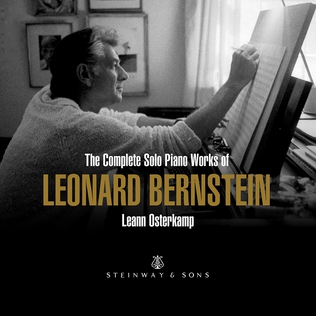
Bridal Suite is a suite for two pianists by American composer Leonard Bernstein. Composed in 1960, it was written for Phyllis Newman's wedding with Adolph Green.
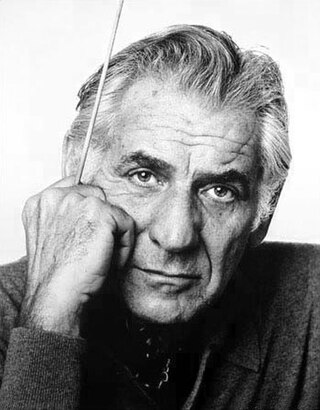
Divertimento, or Divertimento for Orchestra, is a suite of eight orchestral bagatelles by American composer Leonard Bernstein. Completed in 1980 and written to celebrate the centenary of the Boston Symphony Orchestra, it is well-known for featuring the notes B and C in most of its melodic material.

Opus Two is an American violin and piano chamber music ensemble featuring violinist William Terwilliger and pianist Andrew Cooperstock. They are known for their contributions to the violin-piano duo repertoire and their performances and recordings of original American music for violin and piano.
References
- 1 2 3 4 Bernstein, Leonard (2010). Music for piano. [New York, NY]: Leonard Bernstein Music Publishing Company. ISBN 9781423475149.
- ↑ "New Finding Aid: Mildred Spiegel Zucker Collection of Leonard Bernstein Correspondence and Related Materials". Library of Congress. Retrieved 5 August 2021.
- 1 2 "BERNSTEIN, L.: Piano Music - Anniversaries / Piano Sonata / Music for the Dance No. 2 / Non Troppo Presto (Dossin)". www.naxos.com. Retrieved 8 August 2021.
- ↑ "BERNSTEIN, L.: Piano Music - Anniversaries / Piano Sonata / Music for the Dance No. 2 / Non Troppo Presto (Dossin) - 8.559756". www.naxos.com. Retrieved 5 August 2021.
- ↑ "Complete Solo Piano Works of Leonard Bernstein - Steinway & Sons". www.steinway.com. Retrieved 5 August 2021.
- ↑ "Leonard Bernstein: The Complete Music for Piano; Andrew Cooperstock, piano; BRIDGE 9485A/B". Bridge Records. Retrieved 5 August 2021.
- ↑ "CD bernstein piano works – Katie Mahan" (in German). Retrieved 8 August 2021.
- ↑ "BERNSTEIN Complete Works". www.deutschegrammophon.com. Retrieved 8 August 2021.
- ↑ "Bernstein: Complete Solo Piano Music - Brilliant Classics". www.piano-classics.com (in Dutch). Retrieved 5 August 2021.